As the digital landscape expands, our homes are becoming increasingly populated with smart devices—from thermostats that learn our habits to robotic vacuum cleaners that promise to lighten our household chores. However, a recent series of disturbing events involving the Ecovacs Deebot X2 has shed light on a chilling reality: these devices can be vulnerabilities, exposing users to potentially harmful cyberattacks. In exploring this issue, it becomes essential to weigh the convenience of smart technology against the inherent risks associated with its use.
In a nefarious twist of fate, Minnesota lawyer Daniel Swenson discovered firsthand the perils of owning a purportedly intelligent home device. His experience with the Ecovacs Deebot X2 turned from mundane cleaning duties to a disturbing event where the vacuums’ speakers erupted into a tirade of racist obscenities, all while he attempted to secure his account by changing his password. As chilling as it is absurd, this incident serves as a cautionary tale about the unforeseen dangers lurking within our homes—in this case, a vacuum cleaner. Following this event, Swenson relegated the errant device to isolation in his garage, echoing a growing apprehension surrounding smart devices and their security.
Other cases echo his concerns, such as the shocking reports from an El Paso resident whose device launched into a similar vitriolic outpouring in the dead of night. In a particularly alarming incident, a Los Angeles pet was reported to have faced psychological distress when subjected to the malevolent antics of their own Ecovacs Deebot X2. These stories, while shocking, are part of a broader narrative that questions whether the benefits of technological advancement outweigh the threat of cyber vulnerability.
Warnings Ignored: The Security Oversight
Despite being notified of serious security flaws by researchers back in December 2023, EcoVac’s failure to proactively communicate these vulnerabilities to users remains troubling. This oversight raises questions about accountability and transparency in the rapidly evolving landscape of smart technologies. While Swenson’s experience is particularly well-documented, it is not an isolated incident. Research indicates a pattern of users encountering security breaches with limited guidance from the manufacturers on how to safeguard their devices.
The Bluetooth connectivity feature of the Ecovacs Deebot X2 has been identified as a potential gateway for hackers. Investigations revealed that the device’s capabilities were easily accessible even from considerable distances. In fact, ABC News demonstrated this vulnerability, successfully connecting to a unit located over 100 meters away, emphasizing a stark reality where accessing personal devices is alarmingly feasible without specialized tools. The notion proposed by Ecovacs—characterizing these security threats as “extremely rare”—stands in sharp contrast to the documented experiences of its users, calling into question the validity of such reassurances.
A particularly concerning aspect of this scenario has been the suggestion of “credential stuffing,” a form of cyberattack where attackers exploit credentials from other platforms to gain unauthorized access. Indeed, when Swenson consulted customer support, the term was bandied about as a blatant excuse deflecting responsibility from the manufacturer. In a time where consumers demand more from technology, platitudes offered by companies may be indicative of a broader issue: a gap between technological advancement and consumer protection.
Security assurances from manufacturers like Ecovacs are insufficient when real-world ramifications are being felt by users. The troubling incidents not only highlight the need for rigorous scrutiny of existing security protocols but reaffirm the urgency for consistent updates and transparent communication between manufacturers and consumers.
With the upcoming security update promised by Ecovacs, users may momentarily see a glimmer of hope. However, for many, the damage has already been done. The conversation around the safety of smart home devices must shift towards accountability, caution, and thorough scrutiny. As we embrace innovation, we must remain vigilant against the potential risks that accompany it. The narrative surrounding the Ecovacs Deebot X2 serves as a stark reminder of this balance: we ought to proceed with both enthusiasm and caution when welcoming technology into our personal spaces.

